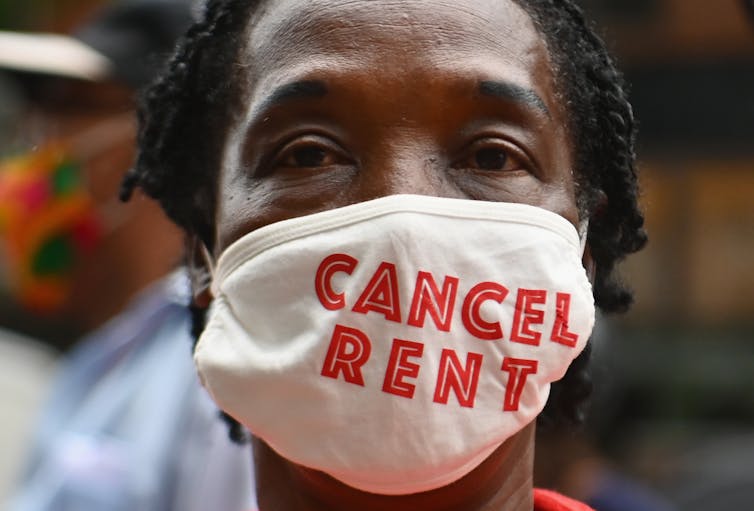
Angela Weiss/AFP via Getty Images
Katy Ramsey Mason, University of Memphis
Editor’s note: The Centers for Disease Control and Prevention issued an order on Sept. 1 banning evictions of people who lost work as a result of the pandemic. To benefit, renters must sign a declaration that they don’t make more than US$99,000 a year or $198,000 for those filing a joint return and that they essentially have no options other than homelessness. But the order, which takes effect on Sept. 4, leaves some questions unanswered. We asked Katy Ramsey Mason, an assistant professor of law and director of the University of Memphis Medical-Legal Partnership Clinic, to answer some of them.
1. What does the order do?
The order prohibits property owners from evicting covered tenants from any residential property because of nonpayment of rent before Dec. 31, 2020. It does not apply to any evictions that might be brought on grounds other than nonpayment, such as nuisance or alleged criminal activity.
It requires tenants to sign and submit a declaration to the landlord certifying under penalty that they qualify for protection under the moratorium. It does not relieve tenants from the obligation to pay rent — all of it comes due on Jan. 1, 2021 — and it allows landlords to continue to charge late fees and other penalties as permitted by law.
2. Who qualifies?
The CDC’s order applies to as many as 40 million renters across the country who could be at risk of eviction for nonpayment of rent.
It is more comprehensive than the Coronavirus Aid, Relief and Economic Security (CARES) Act eviction moratorium, which expired on July 24 and only applied to an estimated 12.3 million renters, or about 28% of rental properties nationwide. The new order applies to tenants who live in any rental property in any place in the U.S. and its territories that does not already have an eviction moratorium with the same or greater protections than the CDC order. There are still 20 states with some form of a moratorium in place, about half of which are more comprehensive than the CDC’s moratorium. All of those moratoriums are unaffected.
Other than the financial requirements, to qualify for relief under the CDC order a tenant must certify that he or she is not able to pay full rent due to substantial income loss and has attempted to obtain government assistance with rent, and must commit to making partial rent payments to the extent of his or her ability.
3. What authority does the CDC have to do this?
The CDC is invoking its powers under federal law to take action to prevent the spread of communicable disease if it finds that state or local prevention measures are insufficient. The order emphasizes the link between homelessness and the spread of COVID-19 and states that the high levels of homelessness that would result from widespread evictions would increase the risk of interstate transmission of the virus.
4. What does it mean for landlords?
The CDC’s order is certain to be unwelcome news for many landlords, who have already been struggling through the pandemic.
Many tenants have been unable to pay rent, and nonpayment evictions have been limited by state moratoriums and the coronavirus relief bill. According to the 2015 American Housing Survey, slightly less than half of rental properties are owned by “mom and pop” landlords, while the rest are owned by business entities. If landlords are not able to pay their mortgages and other costs, it could result in a loss of affordable housing units across the country.
Under the CDC’s order, landlords can continue to collect rent and charge late fees and other penalties, but they cannot evict tenants who don’t pay. The order also does not allocate any additional funding to assist tenants or landlords with unpaid rent, but encourages local governments to use coronavirus relief funds that have already been distributed towards rental assistance programs.
5. How will it be enforced?
Unlike the CARES Act moratorium, which had no enforcement mechanism, the CDC eviction moratorium imposes significant criminal penalties on violators. An individual who violates the order can be fined up to $100,000 and/or one year in jail. If a death results from the violation, the fine increases to up to $250,000.
If an organization or company violates the order, the monetary fines increase to a maximum of $200,000 if there is no death and $500,000 if there is a death. The order authorizes the Department of Justice to “initiate court proceedings” to seek those penalties.
6. What happens when the order expires?
When the order expires on Dec. 31, landlords will again be able to initiate eviction proceedings in accordance with state law — unless the moratorium is extended. If tenants have been unable to pay their full rent up to that point, they will be responsible for all of the arrears that have accrued — putting them at risk of losing their homes in the middle of winter. Some members of Congress have been pushing for additional funding to assist tenants — and landlords — with unpaid rent, but negotiations over another relief bill remain stalled.![]()
Katy Ramsey Mason, Assistant Professor of Law and Director of the Medical-Legal Partnership Clinic, University of Memphis
This article is republished from The Conversation under a Creative Commons license. Read the original article.

